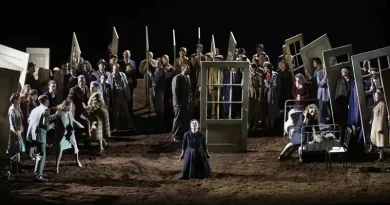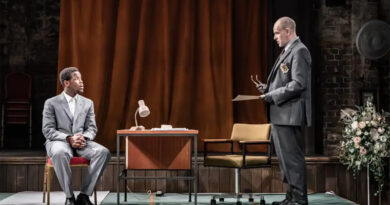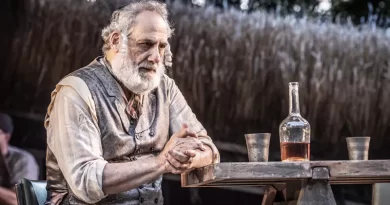“The Glass Menagerie” at Yard Theatre
Neil Dowden in East London
March 15 2025
Tennessee Williams made his name in 1944 with the lyrical domestic drama The Glass Menagerie. Founding artistic director Jay Miller has chosen it as the final show in this incarnation of the Yard Theatre in Hackney Wick which, as a converted warehouse and largely made from reclaimed materials, was supposed to be a six-month pop-up when it opened in 2011. Since then, this 110-seater has punched well above its weight as one of London fringe theatre’s most innovative venues that encourages emerging talent. But a new theatre building with twice the capacity and improved facilities will open in the same location next year. In the meantime, with this magical production, the Yard is going out on a high.

Sharon Small as Amanda.
Photo credit: Manuel Harlan.
Williams’s elegiac, semi-autobiographical work depicts the tensions within the Wingfield family in St. Louis, Missouri in the 1930s. As the narrator/protagonist and son/brother Tom tells us at the outset, looking back on what happened many years before: “I give you truth in the pleasant disguise of illusion . . . Being a memory play, it is dimly lighted, it is sentimental, it is not realistic.” And Miller takes this as a cue for his highly imaginative, expressionist staging that proceeds in a seductively dreamlike atmosphere. Although certain references in the text and images on stage connect it to the pre-war American South, this show feels more like an imagined past than a precise historical period.
Indeed, the air of creative mystery starts when the audience enter the auditorium as we see a murky figure wearing a head torch and apparently spray painting a wall, whom we soon find out is Tom, as he sets the scene like the writer he always wanted to be. When he is in narrator mode the other three performers stop moving, frozen in time, until he reawakens them through his final vivid memories of his impoverished genteel family.

Tom Varey, Sharon Small and Eva Morgan.
Photo credit: Manual Harlan.
After his father – “a telephone man who fell in love with long distances” – has long since abandoned them, his determined but domineering mother Amanda is continually exhorting him and his vulnerable sister Laura to do better. When Amanda finally persuades Tom to bring home a “gentleman caller” – his shoe warehouse colleague Jim – for the painfully shy Laura, the family reaches crisis point.
Their plight is powerfully conveyed in evocative flashbacks that have a super-real feeling. Great use is made of The Shed’s industrial space, including an emergency exit representing the apartment block fire-escape. (At the end the latter is used for Tom to repeatedly circle around the outside of the auditorium and then re-enter the other side, presumably mimicking his recollections on a loop.) Miller occasionally overdoes the ideas, but there are many visually arresting moments such as characters emerging Narnia-like from a wardrobe. Most importantly this is a moving account of the fragile relationships at the heart of the play.
Cécile Trémolières’s striking, non-naturalistic set design has different spaces divided by strip curtains, with traditional furniture and small glass animals on suspended multi-tiered shelves that rotate; as well as a heap of sand and bricks covered in debris such as a disconnected telephone and discarded flowers like the remnants of a decaying home, with a giant portrait of the absent father on one wall. The bizarrely colourful costumes (by Lambdog1066) also have a surreal quality, as if they have been taken from a dressing-up box.
Sarah Readman’s superb, shadowy lighting includes a blackout (after the family’s electricity has been cut off) followed by a beautifully intimate candlelit scene for the tête-à-tête between Laura and Jim. Josh Anio Grigg’s sound design also contributes to the haunting ambience (including distorted voices), as does the eclectic music (inspired by the proximity of the Paradise Dance Hall), though this is overused in the first half so that it becomes an irritating distraction from the human drama.
The cast’s performances are all beautifully modulated. Tom Varey’s guilt-ridden but frustrated Tom is evidently torn between his sense of responsibility for his mother and sister and his overwhelming need to escape into the wider world. Sharon Small’s Amanda is less fading Southern belle and notably more sympathetic mom than usual: although you can understand why her children find her attentions stifling, as a single mother trying to make ends meet you really feel she wants the best for them. Eva Morgan makes a tremendous professional stage debut as the delicate, reclusive Laura, whose affliction seems to be less physical than psychological, in a touching portrayal of unrequited love. And Jad Sayegh is equally assured in his debut as the underachieving but eternally optimistic Jim who still thinks his future is rosy.
As the fastest-selling show in the Yard’s 14-year history, The Glass Menagerie has already had its run deservedly extended. Like the story itself, the production has created potent memories – and on this sort of form no doubt the theatre’s future is also bright.









